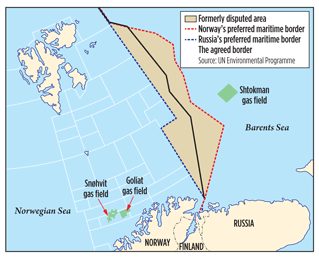Vol. 232 No. 10
OIL AND GAS IN THE CAPITALS
|
ØYSTEIN NORENG, CONTRIBUTING EDITOR, NORTH SEA
|
Exploring the Barents Sea after the Norwegian-Russian border treaty
|

|
Earlier this year, the treaty establishing the boundary between Norway and Russia in the Barents Sea and the Arctic Ocean was ratified by the two countries’ respective parliaments. In contrast with the 1965 treaty between Norway and the UK, which established the median line of the North Sea as their maritime border, the present treaty builds on a compromise between the median line, advocated by Norway, and the sectoral line claimed by Russia. By marking a border, the treaty brings to the area legal clarity and predictability, which are preconditions of a secure framework for oil and gas exploration.
The treaty introduces provisions for cooperation and dispute resolution in relation to the exploitation of any petroleum deposits that may straddle the maritime border, modeled after the UK-Norway agreement. The essential point is unitization as the basis for joint development and distribution of any such discoveries.
A true frontier. The petroleum resource potential of the Barents Sea is uncertain; it is a separate geological system from the other parts of the Norwegian continental shelf to its south. Most of the area has not been subjected to up-to-date seismic surveys, and even less has seen exploration drilling. The regional geology is characterized by large structures that, in theory, should be oil and gas prone. In practice, the oil and gas have been difficult to trace, as the resources seem to have migrated.
Conventional wisdom suggests that the most prospective areas are in the Russian sector, where several gas finds have already been made. The US Geological Survey gives higher marks to the Norwegian margin than to the Barents platform, which includes the formerly disputed area. The USGS points to the Hammerfest basin offshore northern Norway, home to the Snøhvit gas field and Goliath oil field. A bit farther north, in the Bear Island fault zone, Statoil discovered an estimated 150–250 million boe of recoverable hydrocarbons—primarily oil—at the Skrugard prospect this April.
Whereas little exploratory work is evident on the Russian side, Norway started a seismic survey in the formerly disputed area as soon as the treaty entered force in July. Following review of the data, the first licensing will likely be in 2013. The area has incomplete and outdated seismic coverage, although finds have been made nearby on both sides of the border.
 |
| Map showing the new maritime border between Russia and Norway in the Barents Sea as well as the formerly disputed area. |
|
For the northern part of the Barents Sea, which has yet to be opened for exploration, knowledge is even more scant. The area largely consists of sedimentary rocks with petroleum potential. During winter, large sections are covered by pack ice.
For the adjacent Lofoten-Vesterålen area, knowledge is more complete due to extensive seismic surveys. Parts of the area appear highly prospective, but, due to environmental concerns, petroleum activity there is a politically contentious issue in Norway. Therefore, the area has been put on hold until after the 2013 parliamentary elections.
A new Norwegian boom? The opening of new territories in the north and recent discoveries in the south indicate that Norway may be a less mature petroleum province than is often assumed. Indeed, huge prospective areas are fallow. After the treaty with Russia and a 2008 border agreement with Iceland, the Norwegian shelf measures about 850,000 sq mi. By comparison, the entire Gulf of Mexico takes up about 620,000 sq mi.
The new frontier and recent discoveries have led to a new optimism in Norway. Prior to these developments, it was generally forecast that Norwegian oil and gas production would continue contracting slowly until about 2020 and then drop abruptly. Now, depending on what the Barents Sea yields, optimists say output will increase again until the 2030s and exceed the previous peak of 2000, while even the most pessimistic assessment sees output remaining at present levels until 2021. The optimistic scenario will require a combination of greatly accelerated activity and remarkable luck. The increased activity might be accomplished by more extensive licensing and better fiscal terms, while luck might be enhanced by advanced technology and increased competition. WO
|
daysew@frionline.com.br / Dayse Abrantes is an independent journalist based in Rio de Janeiro. She has traveled widely in Latin America, and has written on the region’s energy sector for two decades.
|
|
|




